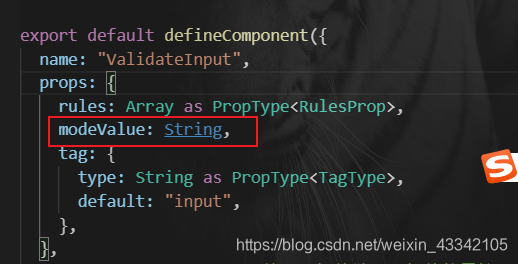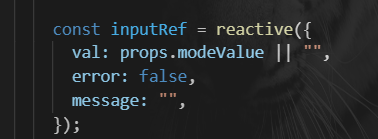本文共 3587 字,大约阅读时间需要 11 分钟。
文章目录
vue2.0自定义v-model组件
注意下面是vue2的自定义v-model组件使得子组件和父组件的其他dom实现双向绑定,但是vue2.0的实现方式有诸多缺点
比如:- 只能双向绑定一个值,不能双向绑定多个值
- 实现方式比较繁琐,并且难以理解
子组件CustomVModel.vue
父组件index.vue
{ { name}}
vue3.0实现自定义v-model

- 必须具备modelValue属性
- 需要在更新的时候必须触发一个onUpdate:modelValue的事件
必须具备modelValue属性
在子组件中ValidateInput:

 vue3.0的context 是 setup() 的第二个形参,它是一个上下文对象,可以通过 context 来访问Vue的实例 this
vue3.0的context 是 setup() 的第二个形参,它是一个上下文对象,可以通过 context 来访问Vue的实例 this  在父组件中:
在父组件中: 

$nextTick
- Vue是异步渲染的框架
- data改变之后,DOM不会立刻渲染
$nextTick会在DOM渲染之后被触发,以获取最新的DOM节点
- { { item}}
点第一次

- 异步渲染,$nextTick 待 DOM 渲染完再回调
- 页面渲染时会将 data 的修改做整合,多次 data 修改只会渲染一次
vue的动态组件
一句话来概括就是将组件以变量的形式进行渲染
语法如下
import HelloWorld from './HelloWorld'export default { components: { HelloWorld }, data() { return { HelloWorldName: "HelloWorld", } }}
vue异步加载组件
异步加载组件的简单理解就是什么时候需要用到什么时候就加载
异步组件不需要用import引入了 在下面是这种方式: FormDemo: () => import(’…/…/BaseUse/FormDemo’) 在components里面引入的
点击这个按钮就会出现FormDemo组件(此组件就不贴代码了)
keep-alive
先从字面意思 上理解,坚持活着,这里的主语是组件,其实本质上就是缓存组件的意思,缓存频繁切换的组件,使其不重复渲染。可以优化vue项目的性能
下面的实例营造了这样一个场景:有三个按钮A,B,C,分别点击不同的按钮,下面会出现不同的 组件,其实本质上就是一个简单的tabBar
将要渲染的三个组件 KeepAliveStageA, KeepAliveStageB, KeepAliveStageC 用 keep-alive 组件包裹,他们就不会被销毁 了,除非页面被关闭
KeepAlive.vueKeepAliveStateA.vue
state A
KeepAliveStageB.vue
state B
KeepAliveStageC.vue
state C
mixin
多个组件之间有相同的逻辑,抽离出来。
这里其实思想和react的自定义hook一模一样
vue3中也有自定义hook的功能了mixin语法有如下缺点:
- 变量来源不明确,不利于阅读
- 多个mixin可能会造成命名冲突
- mixin和组件可能出现多对多的关系,复杂度较高
朋友们不需要担心,现在vue3出来了,里面也有自定义hook了,完全可以代替mixin
下面一个场景就是,如果多个组件都需要使用到showName方法,就可以showName方法写到一个单独的js文件中,但是此js文件用的是vue的script相同的模板
mixin.js
export default { data() { return { city: '北京' } }, methods: { showName() { // eslint-disable-next-line console.log(this.name) } }, mounted() { // eslint-disable-next-line console.log('mixin mounted', this.name) }} 将mixin.js引入到要渲染的组件,这个组件用到minxin的showName方法和city属性
{ { name}} { { major}} { { city}}
vue3中的自定义hook函数
下面的自定义hook函数传入参数是一个dom节点,监听document中的点击事件,看点击的区域是否在这个节点内部
import { ref, onMounted, onUnmounted,Ref } from "vue";const useClickOutside = (elementRef: Ref ) => { const isClickOutside = ref(false) const handler = (e: MouseEvent) => { if (elementRef.value) { if (!elementRef.value.contains(e.target as HTMLElement)) { isClickOutside.value = false }else{ isClickOutside.value = true } } } onMounted(() => { // console.log(123132132); document.addEventListener('click', handler) // console.log(isClickOutside.value); }) onUnmounted(() => { document.removeEventListener('click', handler) }) return isClickOutside}export default useClickOutside const isClickOutside = useClickOutside(dropRef); watch(isClickOutside, () => { // console.log(isClickOutside.value); if (isOpen.value && !isClickOutside.value) { console.log("watch"); isOpen.value = false; } }); 转载地址:http://jyue.baihongyu.com/